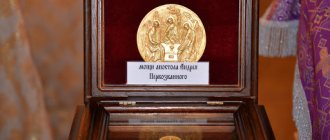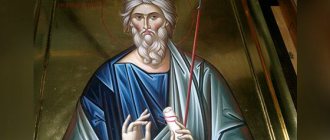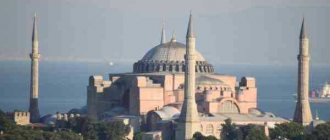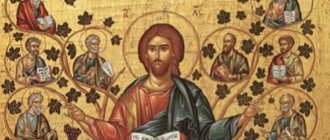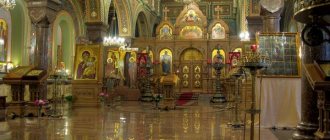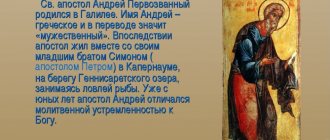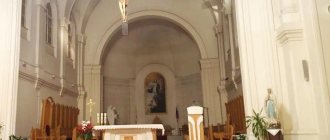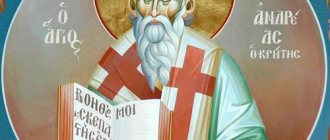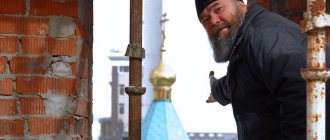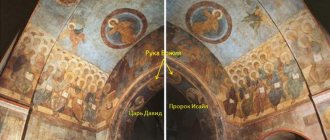The history of the Church of the Apostle Andrew began with the construction of a temple in the name of St. Tikhon.
The history of the Church of the Apostle Andrew begins on April 13, 1999, when His Holiness Patriarch Alexy II of Moscow and All Rus' was still the head of the Russian Orthodox Church (ROC).
April 13, 1999
from this day the Church of the Apostle Andrew begins its history
He arrived in Lyublino, where there was not yet a single church, and consecrated the foundation stone for the throne of the future church in the name of St. Tikhon, Patriarch of All-Russia.
The church was located on the territory of the Orthodox community of Apostle Andrew the First-Called. It was a small wooden church for 120 - 150 people.
Construction of the first church in the temple complex
The first services began in the basement (ground floor) of the temple on January 1, 2000. At this time the temple itself was being built and the parish was growing. Its consecration took place on the bright spring holiday - Annunciation (2001).
The services themselves, in the then wooden church, began on Easter 2003. The temple began to be ennobled and covered with facade stone.
Since 2006, on the territory of the temple complex there has been a children's Orthodox singing gymnasium “Lublino” (9 classes). In addition to the usual school and music education, children also receive spiritual education.
Orthodox singing gymnasium in Lyublino
With the growth of the parish, the question of building a new large cathedral became acute. The Church of the Apostle Andrew the First-Called (designed for 1,500 people) appeared to them.
The construction of the temple was announced on the patronal holiday.
In his speech to the people, Archpriest Viktor Shkaburin said:
“Today we have an unusual patronal holiday. Today we celebrate our anniversary!
Our parish is 20 years old! During this time, we created a strong Orthodox community, a spiritual family.
We organized the education of our children in the Orthodox gymnasium.
And this year we already had our first graduation, and all our students entered the colleges of their choice.
We are 20 years old!
And finally, the time has come to begin the construction of the main capital temple.
All the preparatory work, which is invisible to the eye, has practically been completed. I ask for prayers!”
Victor Shkaburin
archpriest
This is what the Church of the Holy Apostle looks like according to the project
The construction of the Church of the Apostle Andrew was included in the “200 churches” program. This program started in Moscow in 2010. The goal is the construction of Orthodox churches in that part of the city where at the moment they are especially lacking, because existing churches cannot accommodate all parishioners.
Thanks to the “200 temples” program, the Church of St. Andrew the First-Called was built. Website of the 200 temples program
The construction of the Church of the Apostle Andrew was included in the “200 churches” program. This program started in Moscow in 2010. The goal is the construction of Orthodox churches in that part of the city where at the moment they are especially lacking, because existing churches cannot accommodate all parishioners.
The peculiarity of the cathedral is that it is supposed to have only 1 dome. There will be no columns in the temple premises. This is very convenient for parishioners, because... nothing blocks the view and you get more space and better acoustics.
The belfry is adjacent to the facade of the building and they form a vast temple area in front of the main entrance to the temple. The cathedral will be beautiful, white stone, like old Russian times.
The Church of the Apostle Andrew is still under construction, so you can see such an announcement at the entrance
Upon completion of construction, it is planned to delineate the “responsibilities” of the temples.
Regular liturgies and baptisms will take place in the church in the name of St. Tikhon, Patriarch of All-Russia; holiday liturgies and educational activities will move to the new church of St. Andrew the Apostle.
The rector of the temple also talks about plans for a concert hall in the Cathedral of St. Andrew the First-Called, where students of the singing gymnasium will perform, an exhibition hall and a museum (ecclesiastical historical).
The temple is still under construction and no services are held there.
Initially, the building allocated to the gymnasium was intended for domestic needs, so it is small in size and not enough for all students. They plan to expand it with the help of a temple under construction, where the gymnasium will occupy the ground floor.
Previously, there were no churches in Moscow named in honor of St. Andrew the First-Called, although he is the first enlightener of Rus', or rather the land where the predecessors of the Slavs lived. Although in Russia the saint is highly revered (the highest order of Russia is the Order of St. Andrew the First-Called, St. Andrew's Cross is the flag of our fleet).
FIVE TEMPLES IN MOSCOW DEDICATED TO THE HOLY APOSTLE ANDREW THE FIRST CALLED
According to legend, the Apostle Andrew the First-Called planted the Cross on the Kyiv mountains and reached Novgorod. This saint has always been revered in Rus'. The military sailors of our Motherland serve under the St. Andrew's flag. The highest state award in Russia is the Order of St. Andrew the First-Called. In Moscow there are churches built and consecrated in honor of the Apostle Andrew.
The legend about the journey of the Apostle Andrew along the Dnieper and Ladoga to Novgorod and beyond first appears in the later edition of The Tale of Bygone Years and dates back to the beginning of the 12th century. However, according to Metropolitan Platon (Levshin), Archbishop Philaret (Gumilevsky), MDA professor Evgeniy Golubinsky, historian Anton Kartashov and others, the story of the Apostle Andrew’s journey through Russian lands is nothing more than pious speculation. But Metropolitan Macarius (Bulgakov), the author of the history of the Russian Church, states the opposite: “The tradition of the gospel of the Holy Apostle Andrew, even in the inner regions of our Fatherland, does not contain anything incredible, and there is no reason to reject it unconditionally or accept it as one idea.”
Church of the Holy Apostle Andrew the First-Called at the Vagankovskoe cemetery
Moscow, Sergeya Makeev street, building 15.
Almost at the very entrance to the Vagankovskoye cemetery in 1822–1824, two outbuildings were built according to the design of the architect Alexander Elkinsky. In 1916, the premises of the parish school, located in one of them, were rebuilt into the Church of St. Andrew the First-Called. A chapel was built under it for the funeral of the dead. The church was small, it could accommodate only 350 people. The consecration of the temple took place in May 1916.
Soon after the revolution, in 1918, the temple was closed. At first, the church building housed a dormitory, and then various cemetery services. During Soviet times, both wings of the Vagankovsky cemetery were taken under state protection. The building was transferred to the Russian Orthodox Church in 1989.
The Church of the Apostle Andrew the First-Called at the Vagankovsky cemetery is the only temple in honor of the Apostle built in Moscow before the revolution. The church is assigned to the Church of the Resurrection of the Word at the Vagankovskoye cemetery. The church building is a cultural heritage site of federal significance.
Church of the Holy Apostle Andrew the First-Called at the Athos Compound
Moscow, st. Goncharnaya, house 6.
The Church of St. Andrew the First-Called is the third church of the metochion and is located inside the refectory chambers. The temple was consecrated in 2006 and became the 70th monastery church in Moscow.
The Athos courtyard is located on Kotelnicheskaya embankment. The monastery is an architectural monument. The oldest church is from the 16th century.
The following shrines are kept at the courtyard: a shrine with the relics of the Venerable Aristoclius, the Elder of Moscow, an icon of the Mother of God “Quick to Hear” with the autograph of the Venerable Aristoclius, icons with the relics of the Great Martyr Panteleimon, the Apostle Andrew the First-Called, and the Venerable Silouan of Athos.
Temple complex of St. Apostle Andrew the First-Called and the Church of St. Tikhon, Patriarch of Moscow and All Rus' in Lublin
Moscow, st. Stavropolskaya, vl. 25.
In 2000, crosses and domes were raised. The minor consecration of the temple took place on April 5, 2001. In 2006, the building of the Orthodox singing gymnasium was built.
Thrones: Upper Church - the throne of St. Tikhon, Patriarch of All-Russia; side altar - in honor of the Lublin Icon of the Mother of God. The lower baptismal church is the throne of the New Martyrs and Confessors of Russia.
Shrines of the temple: an icon of St. Tikhon the Patriarch of All-Russia with a particle of relics, an icon of the Hieromartyr Vladimir, Metropolitan of Kyiv with a particle of relics, an icon of the Blessed Matrona of Moscow with a particle of the coffin, a reliquary with particles of the relics of Russian saints.
The Church of St. Apostle Andrew the First-Called under construction on Warsaw Highway
Moscow, Varshavskoe highway, vl. 100.
The Church of the Apostle Andrew the First-Called will take special care of the Russian fleet.
This small single-domed church will be located at the very beginning of Chernomorsky Boulevard, on an asphalt area free of trees. The capacity of the temple will be 250 people; height – about 15 meters (excluding dome and cross).
One of the chapels of the temple will be consecrated in honor of the holy righteous warrior Theodore Ushakov, an outstanding Russian admiral and commander of the Black Sea Fleet.
Foundation stone of the Church of St. Apostle Andrew the First-Called in Metrogorodok
Moscow, Otkrytoe shosse, vl. 31.
The temple in the Metrotown area on the Open Highway is being built within the framework of Program 200. Nearby was built a small wooden church of the Holy Blessed Prince Daniel of Moscow.
Prepared by Deacon Sergiy Pravdolyubov Published: No. 5 (570), March 2015
We kindly ask you to support the work of the website of the newspaper “Orthodox Moscow”.
The donation can be transferred to a Sberbank card: 4274 3200 3865 4060 TO ORDER ONLINE CLICK HERE
Schedule of services in the temple complex
The schedule of services is posted on the official website of the temple.
Temple complex of St. Andrew the First-Called Apostle Official website
The schedule is updated monthly. In addition to the Liturgy, conversations are held in the church.
- Conversation with the rector;
On Saturdays, at the end of the evening service (at about 19.00), the rector of the church, Father Victor, answers questions from parishioners.
- Gospel Conversations;
On Thursdays after the evening service at 7:30 p.m., Priest John Koval gives talks about Faith and the life of the Church.
- Conversations about holy ascetics;
On Fridays, at the end of the evening service (at about 18.30), conversations are held about the history of the Church, the life of the Holy Ascetics of Piety. Conducted by Alexander Evgenievich Chermensky
- Public conversations.
In our church, public conversations are held for adults and children over 12 years of age who consciously wish to be baptized, as well as for parents of baptized children and those who want to become godparents.
Conversations are held in the church every Saturday at 15:00. Without public conversations, the sacrament of baptism cannot be performed (except in the event of a fatal illness of the person wishing to be baptized).
Church history
At first the church was located in a small house converted into a chapel. The Englishmen living in Moscow bought the house along with the land from Ensign Naumov in 1814. By the 70s of the 19th century, it became obvious that the expanding English community needed new premises. And so in 1882, construction of the temple began on Voskresensky Lane. It was built according to the design of the English architect Richard Neil Freeman. The architect himself, as far as is known, did not even come to Russia, but simply handed over the finished project and drawings to the customers. Be that as it may, this typical English basilica with four small turrets looked very exotic in Moscow, and in the end it turned out to be almost the only building thanks to which the name of the architect became famous.
In 1885 the church was consecrated. It was named after the heavenly patron of Scotland (and also, by the way, Russia and Greece), St. Andrew the First-Called, because in the 19th century the majority of the British community in Moscow were Scots. This is also noticeable in the two terracotta angel figures that greet visitors at the entrance: they are holding thistle flowers, a common symbol in Scottish heraldry.
In the 1920s, the church, like many other churches in Moscow, was closed and converted into a warehouse, then into a residential building with communal apartments. True, it was difficult to live here due to the powerful acoustics (due to its design, the wooden ceiling perfectly reflects sound waves). Therefore, at the end of the 50s, the communal apartments were resettled, and the temple building was handed over to the famous.

